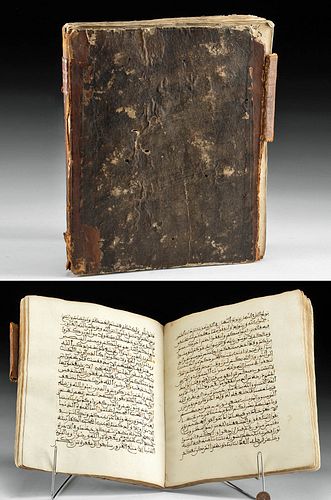17th C. North African Maghrib Koran Surah Manuscript
Lot 233
About Seller
Artemis Gallery
686 S Taylor Ave, Ste 106
Louisville, CO 80027
United States
Selling antiquities, ancient and ethnographic art online since 1993, Artemis Gallery specializes in Classical Antiquities (Egyptian, Greek, Roman, Near Eastern), Asian, Pre-Columbian, African / Tribal / Oceanographic art. Our extensive inventory includes pottery, stone, metal, wood, glass and textil...Read more
Categories
Estimate:
$50,000 - $75,000
Absentee vs Live bid
Two ways to bid:
- Leave a max absentee bid and the platform will bid on your behalf up to your maximum bid during the live auction.
- Bid live during the auction and your bids will be submitted real-time to the auctioneer.
Bid Increments
| Price | Bid Increment |
|---|---|
| $0 | $25 |
| $300 | $50 |
| $1,000 | $100 |
| $2,000 | $250 |
| $5,000 | $500 |
| $10,000 | $1,000 |
| $20,000 | $2,500 |
| $50,000 | $5,000 |
| $100,000 | $10,000 |
| $200,000 | $20,000 |
About Auction
By Artemis Gallery
Mar 24, 2022
Set Reminder
2022-03-24 10:00:00
2022-03-24 10:00:00
America/New_York
Bidsquare
Bidsquare : Exceptional Antiquities Ethnographic Fine Art
https://www.bidsquare.com/auctions/artemis-gallery/exceptional-antiquities-ethnographic-fine-art-9057
Museum-worthy examples of classical antiquities (Egyptian, Greek, Roman, Near Eastern), Viking, Far East / Asian, Pre-Columbian, African / Tribal, Oceanic, Native American, Spanish Colonial, Fossils, Ancient Jewelry, Fine / Visual Arts, so much more! Artemis Gallery info@artemisgallery.com
Museum-worthy examples of classical antiquities (Egyptian, Greek, Roman, Near Eastern), Viking, Far East / Asian, Pre-Columbian, African / Tribal, Oceanic, Native American, Spanish Colonial, Fossils, Ancient Jewelry, Fine / Visual Arts, so much more! Artemis Gallery info@artemisgallery.com
- Lot Description
North Africa, Morocco, ca. 17th to 18th century CE. A rare example of an Islamic manuscript contained in a leatherbound book with beautiful handwritten calligraphy using Maghribi script. The cover is leather over paperboard, with Latin lettering in gilt: "CORANUS ARABICE" printed on the red spine. The cover is likely a later European addition to protect the interior pages. The calligraphy is penned in black and punctuated with red, green and yellow hued ink, adding a hint of vibrancy to the text, as well as the beige-hued vellum. Considered the beginning of manuscript illumination and decoration, these punctuation marks were first added to Kufic Koran in the 9th and 10th centuries to aid in the pronunciation and recitation of the text; thus, increasing its visual and auditory aesthetic. Reciting the Koran correctly is a highly regarded art in the Islamic faith and is called "tajwid," an Arabic term that literally translates to "beautification." Intricate geometric drawings on several pages further embellish the text. This is perhaps the 38th chapter or surah of the Koran until the end. The ownership of this book is also noteworthy as well and documented inside the cover. Please see below for more information. Size: 9.75" L x 8" W x 0.675" H (24.8 cm x 20.3 cm x 1.7 cm)
The first layer of paper pasted to the cover flap is a paper ex libris for the Bibliotheca Lamoniana. The Lamoniana library was the cumulation of two centuries of book collecting by the Lamoignon family who were part of the French nobility. In the late 18th century, the library was sold, and many books ended up in English collections. A stamp in black ink with a "L" encircled is stamped on a page near the beginning of the text, further indicating Lamoignon ownership. Atop the ex libris plate is a nearly translucent paper with handwritten notes in French that indicate this text may be the 38th chapter of the Koran, known as the Saad (Sad) written in African Arabic script (Maghribi), until the end of the book. The verso of this paper also contains writing, and due to the translucency, some of this script is visible, though backwards, and appears to have the signature for Monsieur A. Isaac Silvestre de Sacy. If this signature is correct, Silvestre de Sacy was a famous linguist specializing in Semitic languages (and also the first Frenchman to try to decipher the Rosetta stone). Finally, an armorial bookplate for the English owner, John Broadley is pasted atop the French annotation.
Provenance: private Washington, USA, collection, acquired before 2000
All items legal to buy/sell under U.S. Statute covering cultural patrimony Code 2600, CHAPTER 14, and are guaranteed to be as described or your money back.
A Certificate of Authenticity will accompany all winning bids.
PLEASE NOTE: Due to recent increases of shipments being seized by Australian & German customs (even for items with pre-UNESCO provenance), we will no longer ship most antiquities and ancient Chinese art to Australia & Germany. For categories of items that are acceptable to ship to Australia or Germany, please contact us directly or work with your local customs brokerage firm.
Display stands not described as included/custom in the item description are for photography purposes only and will not be included with the item upon shipping.
#163043Turn in flap cover is not attached and is loose. Covers are delicate and have fraying, tearing, perforations and creasing. Spine is fragile and binding is worn and cracked but retains most of the title text. Inactive old insect worm holes on covers. Pages are in good condition with great preservation to the ink. Some staining, discoloration, and smudging. Front page has several modern pencil notations.Condition
- Shipping Info
-
All shipping is handled in-house for your convenience. Your invoice from Artemis Gallery will include shipping calculation instructions. If in doubt, please inquire BEFORE bidding for estimated shipping costs for individual items.
-
- Buyer's Premium



 EUR
EUR CAD
CAD AUD
AUD GBP
GBP MXN
MXN HKD
HKD CNY
CNY MYR
MYR SEK
SEK SGD
SGD CHF
CHF THB
THB















